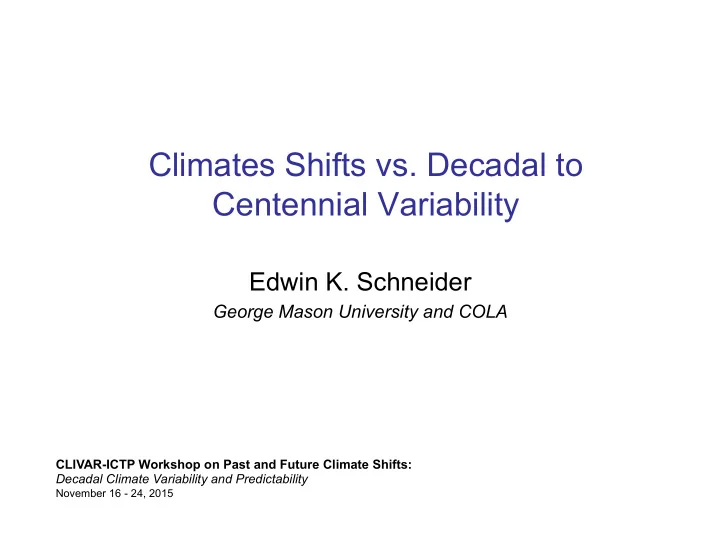

Climates Shifts vs. Decadal to Centennial Variability Edwin K. Schneider George Mason University and COLA CLIVAR-ICTP Workshop on Past and Future Climate Shifts: Decadal Climate Variability and Predictability November 16 - 24, 2015
Acknowledgments Zaiyu Wang, GMU PhD student We did “research” online to survey the literature for this talk. • Google scholar search “climate shift” • Google scholar search “regime shift” • Etc.
Concepts • Climate is the statistics of instantaneous “weather” variables • Climate variability – Change in mean – Change in other statistics (variance, frequency correlation, structure, ..). – Climate shift (provisional): a change in the statistics that persists for much longer than the transition time , so it is a type of climate variability. • Some people use climate shift for a change in sign of some index (AMV, PDV, net TOA heat flux, … ), no constraint on time scale for transition.
Climate vs. Weather • Weather is instantaneous values of weather variables • Climate is a lagging indicator – you don’t know what the current climate is until it’s the past climate. • Climate prediction vs. weather prediction • Have to wait 10 years to verify a decadal climate prediction • A weather prediction verifies against instantaneous data. • Examples • An seasonal ENSO prediction is a weather prediction for SST. • A seasonal hurricane forecast is a climate prediction.
Climate Regimes • Climate shifts are related to the concept climate regimes and the terms climate shifts and regime shifts are used interchangeably. – Regimes are distinct “climates,” and are motivated by the 3- variable nonlinear Lorenz attractor model • The regimes are regions surrounding the (unstable) fixed points (steady solutions). • The transitions between different regimes can be thought of as climate shifts. • A climate shift by my definition would then be a regime change that lasts much longer than than the transition time. • Climate shift is a cousin to abrupt climate change . Abrupt climate change longer than decadal/centennial
Stocker 1999
Stocker 1999
Changes in the Statistics: Mean and Variance
Differences in mean state AMV Differences in variability Δ SST Difference in SSTA standard deviation
Recent Climate Shifts • 1976/7 (shift in mean) • 1988/9 (shift in mean) • 1998-2015 (shift in the trend) • NAO/AMV 1995/6
1976 Climate Shift (Also the year satellite observations began) • Trenberth, 1990: Recent Observed Interdecadal Climate Changes in the Northern Hemisphere.
Zhang, Wallace, and Battisti 1997 ENSO SST Multidecadal ENSO Multidecadal
Mantua et al. 1997 PDO
Minobe 1997 Coherent changes in a number of indices = regime shift
Climate Networks • Network is a vector of indices: normalized PDO, NAO, ENSO, AMO + distance metric Distance Global T ENSO 1920 1940 1980
Climate Shift -> Decadal Oscillation -> Multidecadal Variability • Trenberth 1990 identified a 1976 change in the North Pacific SST and SLP • Graham 1994 pointed out a1976 transition in the tropics • Zhang, Wallace and Battisti 1997 showed what is now called the PDV pattern after linearly removing ENSO. • Mantua et al. 1997 pushed the PDO back to 1900 • 2015: 1976/7 is change of sign in PDV index
1988/9 Regime Shift? • Change of sign of PDV, mentioned in ~2000 (Hare and Mantua) • Also changes in fish abundances in North and Baltic Seas noted in late 1990s PDV
Change in Global Mean Temperature Trend • Reduced trend 1998 to present • Lots of press, erudite explanations • Data reevaluated, new correction applied: – Conclusion: never mind
NAO/AMV 1995/6 Shift NAO
NAO Shift • Schneider, E. K., L. Bengtsson, and Z.- Z. Hu, 2003: Forcing of Northern Hemisphere climate trends. J. Atmos. Sci. , 60 , 1504-1521. • NAO trend 1950-1999 consistent with atmospheric noise (AMIP ensemble statistics, all members with same observed SST)
Conclusions • Climate shifts can be defined as a rapid change between distinct climate regimes to distinguish them from quasi- oscillatory climate variability on decadal to centennial time scales. • It is difficult to find evidence of obvious climate shifts defined in this way in the recent record, but plenty of examples of “regime changes.”
Recommend
More recommend